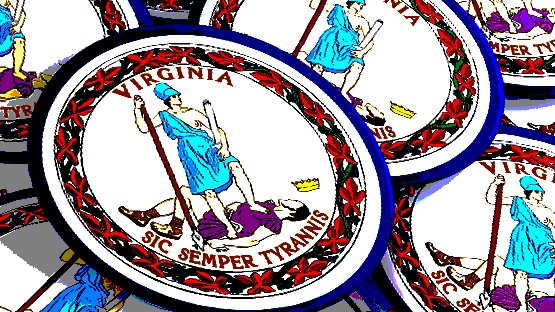
OK, so it’s obvious, on the surface, and we’re all conceding that point: that the talent drain is hitting us all hard right now.
It’s not so much the talent drain as to the why behind the talent drain.
And the guys raising issue with the why aren’t conceding that it isn’t in fact a case of the emperor, in the case of Virginia Basketball, coach Tony Bennett, having no clothes, from a recruiting standpoint.
Putting it bluntly: Tony screwed up, big time, and that’s why we’re seeing the talent dropoff.
The first issue raised is with the 2017 class, the one after the one from 2016 that brought in the Big Three that were the foundational pieces for the 2019 national-title team (Kyle Guy, Ty Jerome, De’Andre Hunter).
The 2017 class was three-stars Marco Anthony and Francesco Baddochi, both of whom have since moved on.
And then, there’s actually some questions being raised about the 2018 class: Francisco Caffaro, a four-star, and three-stars Kihei Clark and Kody Stattmann, along with transfer Braxton Key.
Some fans are even raising issue with the work done in 2019, though I’d argue that anybody ready to cast four-star guard Casey Morsell off the island on the first makeshift raft are idiots; while also positing along with some of the rest of you that, nice kid, but Tomas Woldetensae isn’t around if either Guy or Jerome hangs around for their final year of eligibility.
OK, to analyze.
Clark has played above his recruiting rankings, and was a key contributor in the 2019 title run, as was Key, and both are foundational pieces for this year’s team.
Caffaro, four-star or not, is a project, as is a Class of 2019 four-star big, Kadin Shedrick, who is redshirting, but on the plus side, both seem good fits as bigs in the Pack-Line and mover-blocker.
Morsell is, ahem, struggling (4.6 ppg, 25.8% FG, 15.4% 3FG), but has been showing glimpses (19 points in the Arizona State win, nine last night in the loss to N.C. State).
Woldetensae, ugh, also struggling (4.5 ppg, 30.6% FG, 32.3% 3FG).
Stattmann: struggling (4.6 ppg, 32.1% FG, 19.5% 3FG).
Morsell, of the three, will get better. When he committed two years ago, the thinking was that this year would see him used as a rotation guy, maybe the first guard off the bench, eventually, behind Guy, Jerome and Key, getting 12-15 minutes a game, and not expected to do much more than produce in spurts and play D, while learning the system, and getting himself into a position to be a leader next year and beyond.
People who expect national-title runs every year won’t get this, but Bennett’s system isn’t easy to pick up.
I’ll bring up here an interview I did with Anthony Gill at the 2014 ACC Tournament, as he was in the midst of the run that saw him become the Anthony Gill that we would come to know, in which I asked him about his dramatic in-season turnaround that year.
You won’t remember this, but as late as the Feb. 10 win over Maryland that season, Gill was only scoring a single point in 10 minutes of floor time, before breaking off a streak of six straight double-digit games encompassing the end of the 2014 regular season and into the postseason.
Gill would eventually become the Gill that would be a two-time KenPom.com Top 10 player of the year guy, but before he could become that guy, he had to figure out the Pack-Line.
Gill told me after one of the wins that led to the 2014 ACC Tournament championship that Bennett had told him that he would struggle on the offensive end as he learned the Pack-Line, but at some point, the bell would go off, he’d know what he was doing without having to think about it anymore, and then his offensive game would grow from there.
That’s going to happen with Morsell; the only question is, is it this year, or next year, when it happens?
Morsell is a Malcolm Brogdon-type. He will be a foundational element for this team going forward.
So, of the young guys on this year’s roster, you’ve got Morsell and Clark to build around, with Caffaro and Shedrick as projects, and I’m not sure what to make of Justin McKoy, a three-star forward who can play the three or four, but hasn’t been able to get consistent minutes this year.
McKoy may end up contributing, but when you look ahead to the Class of 2020, which adds three four-stars – 6’6” three Jabri Abdur-Rahim, 6’3” point guard Reece Beekman and 6’3” shooting guard Carson McCorkle – plus transfer Sam Hauser, a 6’9” senior stretch four, there may not be a lot of minutes left hanging around out there.
When you look at that 2020 class, it’s like your trip to the grocery store on the weekend, to stock up for the week ahead.
You had to be looking at 2020 as the year that you’d need your next crop of guards, and, I mean, come on, Abdur-Rahim is your De’Andre Hunter, and Beekman and McCorkle your Jerome and Guy.
Throw them in with Clark, Morsell, Hauser, Caffaro, Shedrick, McKoy and assume you get Jay Huff back for a redshirt senior year, and you’re 10 deep, which is already an excess of talent, and that’s not considering that you have questions about the status of Stattmann and Woldetensae going forward.
(I assume one or both moves on, but that’s not even informed speculation, just a hunch, on my part.)
No way you look back two years ago and assume that you’re playing 2019-2020 without any of the trio of Dre, Ty and Kyle.
Dre, yes; I remember talking with an NBA advance scout before the home opener in 2017 about who he was there to watch, and the first guy he mentioned was Hunter, who at that point hadn’t yet played a college game.
Jerome, though? No, hell no: his other offers were along the lines of Columbia, Davidson, Fordham, Hofstra.
And Guy, the most talented guy in that bunch, is also the one that you knew would have the most trouble getting to the next level because of his size.
You weren’t even playing it safe to assume two years ago, last year, that you’d have either Jerome or Guy back; that’s what was going to happen.
But, but, but, but, you want to argue, so what? Just because you assume those guys are going to be around doesn’t mean you reach in 2017 for two three-star guards, in Anthony and Badocchi, and then another pair of three-star guards in 2018, in Clark and Stattmann.
Shouldn’t you always be recruiting four- and five-star guys pretty much all the time?
I mean, it’s not like Virginia isn’t a big-time player now; we’re talking about a program that’s averaged 29 wins a season over its past six, with four ACC regular-season championships, two ACC Tournaments, that national title.
So, actually, no, not the way you do recruiting, not in today’s game.
Yeah, sure, back into the 1980s, for most of the 1990s, the Carolinas, Dukes, Kentuckys, they could stockpile McDonald’s All-Americans, tell them they wouldn’t get minutes right away, maybe not until they were upperclassmen.
Kids today, though? Tell a Top 50 recruit that they’re not going to play.
For example, Nassir Little, the UNC recruit last year, who couldn’t even crack the starting lineup on a loaded Carolina team.
He just up and left for the NBA anyway, and was a first-round pick.
And as many of those one-and-done kids pick Duke and Kentucky, you have the next-level guys down, the lower five-stars who aren’t quite one-and-done, maybe are two-and-dones, and the high four-stars, same talent ceiling, they’re going where they can get minutes.
It doesn’t take much to figure, if you’re a four-star guard in the Class of 2017, for instance, and you’re interested in Virginia, well, damn, they’ve already got three guys who they’re building around.
I can go there and try to compete for minutes, but I’m a year behind those guys, and that system that Coach Bennett uses is tough to pick up.
It’s so tough to pick up that they redshirted Hunter, who would be gone after his third year as the #4 pick in the NBA Draft.
So, I go there, I fight three NBA guys for minutes, for at least my freshman and sophomore years, and maybe my junior year on top of that, or I try my luck somewhere else.
That’s why, if you’re Bennett, you take projects in the off-years.
You don’t build a roster like David Stern building the Dream Team in 1992.
Everybody has 13 scholarships to give out, but most coaches go with rotations in the range of seven, eight, maybe nine or 10.
Bennett usually limits his minutes to eight guys; Jim Boeheim and Coach K can go as low as six; Leonard Hamilton will go as high as 12.
How many ever guys you have in your rotation, you’ve got two, three guys who do the bulk of your scoring, and then other guys fill roles: defensive stopper, rebounding, moving the ball, hitting the open three when needed to stretch the defense for the bigs and dribble-drives.
Which is to say, you don’t recruit the same type of guy 13 times to flesh your roster out.
But when you look back at Bennett’s rosters from the past several years, you can see what he’s looking for in terms of different types.
Malcolm Brogdon, to me, compares to Ty Jerome, and then down to Casey Morsell and Reece Beekman.
Justin Anderson was the original De’Andre Hunter, ahead of Jabril Abdur-Rahim.
Joe Harris becomes Kyle Guy becomes Carson McCorkle.
Akil Mitchell, Darion Atkins, Isaiah Wilkins, Mamadi Diakite.
Mike Scott, Anthony Gill, Sam Hauser.
Mike Tobey is Jay Huff, as Jay Huff is Mike Tobey.
Kihei Clark is Cali Cool as London Perrantes, with a sprinkle of Jontel Evans.
OK, this is fun, and the real fun thing is, each group is a little better than its predecessor, because the access to talent gets better as each successive group achieves more.
Those raising issue with the 12-6 start to the 2019-2020 season are fatalists thinking that the run is somehow coming to an end, when in fact what’s going on is part of the growth.
Before this past April, Bennett had lost one kid early to the NBA, Anderson, back in 2015, and when you think about it, how good would that 2015-2016 team that was 10 minutes away from a Final Four have been with Anderson back for his senior season?
The original gap year of the Bennett era was the next season, 2016-2017, with Perrantes back from the first mega-successful group for a senior season that had him breaking in Guy and Jerome for what was to come next.
That crop was so good that it didn’t stick around to pass the torch to Morsell, but …
Yes, I know.
This year is painful.
When folks say, In Tony We Trust, it’s not blind fealty; it’s a statement of keen understanding of how Bennett goes about building a roster to fit a demanding system that can win consistently at the highest level of major college basketball, and do so within the structure of a demanding academic environment without compromising on the ideals of that academic environment.
OK, so, he missed on a couple of kids in 2017.
It’s OK.
Relax.
Story by Chris Graham










